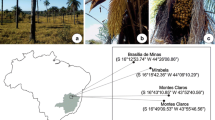Abstract
The phenology, major floral characteristics, fruiting levels, and breeding system ofCistus ladanifer L. (Cistaceae), a common western Mediterranean shrub species, were studied in a southern Spanish population. The white, large (64 mm in diameter) flowers of this shrub appear during spring (March–May) and produce abundant pollen and nectar. In the year of study, flowers lasted up to three days, during which they were visited by a diverse array of insects including beetles, flies, and bees. Hand-pollinations revealed that flowers do not set any seed unless cross pollen is applied to the stigma. Microscopical observations indicate that self pollen tubes grow down the stigma but invariably fail to induce fruit maturation. At the plant level, all estimates of fecundity investigated (number of seeds per capsule, proportion of ovules developing into seed, and proportion of flowers setting fruit) were highly dependent on nearest neighbour distance, with isolated plants setting as little as 0% fruit. In contrast, plants within a clump often transformed into fruit as much as 90% of the flowers. At the population level, seed output was estimated to range between 3,000 and 270,000 seeds per plant during 1991.
Similar content being viewed by others
References
Barrett, S. C. H., 1988: The evolution, maintenance and loss of self-incompatibility systems. — InLovett-Doust, J., Lovett-Doust, L., (Eds): Plant reproductive ecology, pp. 98–124. — New York: Oxford University Press.
Bawa, K. S., Webb, C. J., 1984: Flower, fruit, and seed abortion in tropical forest trees: implications for the evolution of paternal and maternal reproductive patterns. — Amer. J. Bot.71: 736–751.
Bornet, M. E., Gard, M., 1919: Recherches sur les hybrides artificiels des Cistes. — Ann. Sci. Nat. Ser. Bot.9: 71–116.
Brandt, U., Gottsberger, G., 1988: Flower phenology, pollinating insects and breeding systems inCistus, Halimium, andTuberaria species in Portugal. — Lagascalia15: 625–634.
Corral, R., Pita, P. M., Perez-Garcia, F., 1990: Some aspects of seed germination in four species ofCistus L. — Seed Sci. Technol.18: 321–325.
Cruden, R. W., 1977: Pollen-ovule ratios: a conservative indicator of breeding systems in flowering plants. — Evolution31: 32–46.
, 1983: Studying nectar? Some observations on the art. — InBentley, B., Elias, T., (Eds): The biology of nectaries, pp. 223–241. — New York: Columbia University Press.
Dansereau, P., 1941a: Etudes sur les hybrides des Cistes. IV. Correlation des characteres duC. salvifolius L. — Canad. J. Res.19: 27–39.
, 1941b: Etudes sur les hybrides de Cistes. VI. Introgression dans la sectionLadanium. — Canad. J. Res.19: 59–67.
, 1943: Etudes sur les hybrides de Cistes. V. Le comportement du ×Cistus florentinus Lam. — Candollea10: 9–22.
Gibbs, P. E., 1986: Do homomorphic and heteromorphic self-incompatibility systems have the same sporophytic mechanism? — Pl. Syst. Evol.154: 285–323.
Herrera, C. M., 1985: Predispersal reproductive biology of femaleOsyris quadripartita (Santalaceae), a hemiparasitic dioecious shrub of Mediterranean scrublands. — Bot. J. Linn. Soc.90: 113–123.
Herrera, J., 1985: Nectar secretion patterns in southern Spanish Mediterranean scrublands. — Israel J. Bot.34: 47–58.
, 1987a: Flower and fruit biology in southern Spanish Mediterranean shrublands. — Ann. Missouri Bot. Gard.74: 69–78.
, 1987b: Biología reproductiva de algunas especies del matorral de Doñana. — Annal. Jard. Bot. Madrid44: 483–497.
, 1991: The reproductive biology of a riparian Mediterranean shrub,Nerium oleander L. (Apocynaceae). — Bot. J. Linn. Soc.106: 147–172.
, 1992: Flower variation and breeding systems in theCistaceae. — Pl. Syst. Evol.179: 245–256.
Heslop-Harrison, Y., Shivanna, K. R., 1977: The receptive surface of the angiosperm stigma. — Ann. Bot.41: 1233–1258.
Heywood, V. H., (Ed.), 1978: Flowering plants of the world. — Oxford: Oxford University Press.
Knuth, P., 1898:Cistaceae. — In: Handbuch der Blütenbiologie II, pp. 134–137. — Leipzig: Wilhelm Engelmann.
Martin, F. W., 1959: Staining and observing pollen tubes in the style by means of fluorescence. — Stain Technol.34: 125–128.
Moreno, J. M., 1982: Estudios ecológicos en jarales (Cistion laurifolii): variación anual de algunos factores del entorno y manifestaciones fenológicas. — Madrid: Fundación March, Serie Universitaria180.
, 1984a: Estudio ecológico comparado de los jarales de Madrid, I. Variación anual de la humedad del suelo. — Lazaroa6: 105–126.
, 1984b: Estudio ecológico comparado de los jarales de Madrid, II. Variación estacional del pH edáfico. — Lazaroa6: 151–168.
Müller, H., 1883: The fertilization of flowers. — London: Macmillan.
Nettancourt, D. de, 1977: Incompatibility in angiosperms. — Berlin: Springer.
Ortiz, P., 1991: Melitopalinología en Andalucía Occidental. — Tesis Doctoral. Sevilla. Universidad de Sevilla.
Papio, C., Trabaud, L., 1990: Structural characteristics of fuel components of 5 Mediterranean shrubs. — Forest Ecol. Management35: 249–259.
Primack, R. B., 1985: Longevity of individual flowers. — Ann. Rev. Ecol. Syst.16: 15–37.
Sokal, R. R., Rohlf, F. J., 1981: Biometry, 2nd edn. — San Francisco: Freeman.
Talavera, S., 1991: Flora y polinización. In: IV Congreso Nacional de Apicultura, pp. 27–38. — Zaragoza: Diputación General de Aragón.
Trabaud, L., Oustric, J., 1989: Heat requirements for seed germination of 3Cistus species in the garrigue of southern France. — Flora183: 321–326.
Troumbis, A., Trabaud, L., 1986: Comparison of reproductive biological attributes of twoCistus species. — Acta Oecol., Oecol. Plant.7: 235–250.
Wiens, D., Calvin, C. L., Wilson, C. A., Davern, C. I., Frank, D., Seavey, S. R., 1987: Reproductive success, spontaneous embryo abortion, and genetic load in flowering plants. — Oecol.71: 501–509.
Wyatt, R., Hellwig, R. L., 1979: Factors determining fruit set in heterostylous bluets,Houstonia caerulea (Rubiaceae). — Syst. Bot.4: 103–114.
Author information
Authors and Affiliations
Rights and permissions
About this article
Cite this article
Talavera, S., Gibbs, P.E. & Herrera, J. Reproductive biology ofCistus ladanifer (Cistaceae). Pl Syst Evol 186, 123–134 (1993). https://doi.org/10.1007/BF00940792
Received:
Revised:
Accepted:
Issue Date:
DOI: https://doi.org/10.1007/BF00940792




